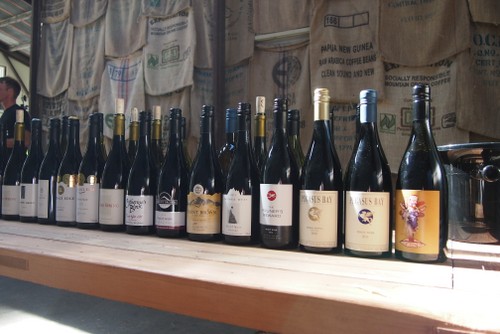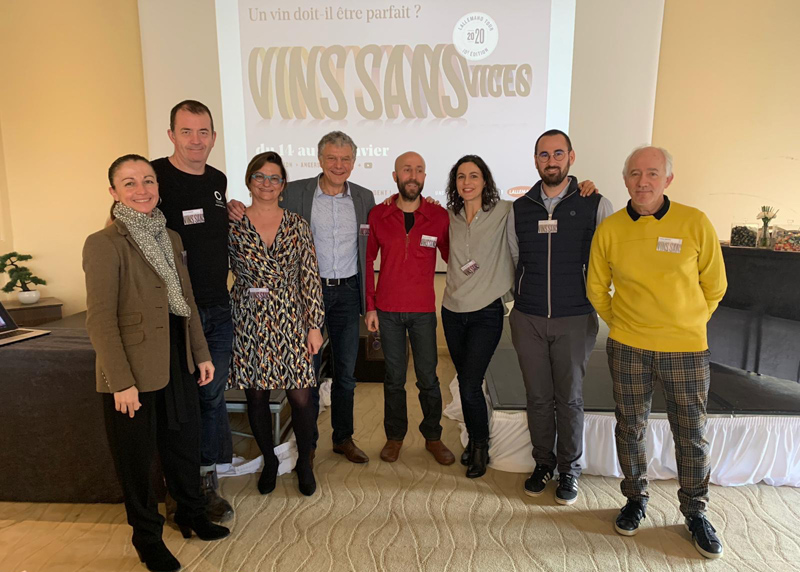
I’m just preparing for this morning’s session at the International Pinot Noir Conference here in McMinnvilla, Oregon. I have to moderate the grand seminar, which will be repeated again tomorrow, with 400 delegates in each session. Our topic, on the perception of wine and the way we use language to describe it, is potentially quite academic. So the first rule is we shall not bore the audience. With eight speakers and 90 minutes, it’s going to be a tight event, which should help us all focus.
So by way of preparation, I thought I’d compose a blog post. It gathers the mind.
As we taste a wine together, is it a common experience for all of us? The unspoken assumption on the part of the wine trade, sommeliers and wine education bodies is that we do indeed share the same experience. We operate as if the taste of the wine is in the glass; that it is a property of the wine. Is this just a pragmatic assumption, in that it would be difficult for us to operate in any other way (personalized menus in restaurants?), or does it stem from a truly shared experience?
Language is the primary window into the private world of another person’s perception. Of course, we can discern something of another’s inner state by non-verbal cues, but it is language that is the window of perception. This is why the way we speak about wine is so interesting and important.
So we will be looking at the way that we use language to describe wine, and how this use has changed over time, and differs among wine cultures. We will look in different practical contexts: how does a wine critic’s use of language to describe wine differ from that of the sommelier, for example?
Which are the best ways to use language to capture the perception of wine? Should be be using reductionist approaches, breaking wine down into its component parts, or should we aim for more holistic, global language that captures the wine as a whole? Is figurative language better than literal?
To what extent is our common language of wine a learned code? Does wine education give us a vocabulary that we then apply to wine, with a poor correspondence to reality? Should we be looking for new ways to describe wine – fresh approaches with greater correspondence to what is in the glass?
What are the cognitive approaches that we use when we try to describe our experience of wine? And do experts and novices do it in a different way?
Finally, how can we do it better?
On a related subject, see this article on whether wine flavour is an objective property.
7 Comments on Thoughts on language and wine

Had a really revealing tasting yesterday with a visitor to our tasting room who it turns out is a good professional chef. He got/perceived aromas and flavours in a completely different and more focused way than a “normal” visitor even those with wine backgrounds. His points of reference were all food based and were amazingly wide ranging. That’s obviously the result of years of working with varied ingredients but it made us really think about how to assess and describe our wines. I think there’s a place, perhaps a need, for reductionism but it should be paired with a holistic conclusion as many wines are more, or less, than the sum of their parts. A sin committed by many professionals seems to me to be to swirl and spit 100+ wines at a time. What possibly value can such a taster’s perception be other than to spot faulty wines which does not add value to the debate.
Have fun in Oregon!
“Is figurative language better than literal?”
Being a down-to-earth science-oriented chap Jamie, I expect your preference would be for more literal or empirical descriptions of wine over the figurative or poetic.
For example, I doubt very much you would describe a Southern Italian red as being “very savage, reminiscent of the wolves that used to roam the hillsides around Naples” as Victoria Moore did recently. I personally think that’s a brilliant use of language. But I can see why people might prefer more neutral descriptors that are less likely to merit an entry in Pseud’s Corner. For example the kind of neutral language used to describe many of the red wines reviewed recently in this blog: “sleek, sweet, ripe, spicy, rich, fresh, floral, pure, focussed, supple …tasting of cherry, plum, blackberry, blackcurrant etc…”
The trouble is when these same relatively neutral and objective decriptors are used repeatedly, after a while all the wines begin to sound more or less the same with little to choose from them. And when descriptions of vintage port (“Vivid aromatic nose of pure black cherry and blackberry fruit, with lovely purity and some floral overtones” “Sweet, ripe, spicy and rich with warm, sleek blackberry and black cherry fruit. A rich, sweet wine with freshness and purity.”) sound almost identical to Frappato (“Sweet, supple, floral nose of red cherries and rose petals. On the palate this shows supple, sweet fruit with red cherries and plums. Fresh, supple, pretty and delicious.”), one wonders if figurative language might actually be more helpful than the supposedly literal or neutral.
As I believe this is an industry event you are attending, I would tend to focus the discussion on the language of wine on what the customer is saying. As industry folk, the language to customers needs to make sense to them and not be too academic. Listening on Twitter is a great place to start. This will help the industry to industry to craft their message to the voice of consumer.
Wow Paul Dove! Nail head, consider yourself hit!
Surely the purpose of wine is to evoke or bring forth a feeling, memory, or image to the conscious mind. This allows us to somehow categorise it or put it in a certain draw in our minds containing other wines with similar characteristics. The trouble is I have no idea how wild the wolves that used to roam the hillsides around Naples were. I do, however, know what a blackberry tastes like.
The problem comes about when I don’t have any or many wines in that same draw, or if I don’t have the experience of a blackberry or the ability to bring that flavour to mind (a skill not to be underestimated).
In that case the wild wolves that roam hillsides speaks to me wonderfully. It creates an emotive response that transports me somewhere where there are no draws or compartments. It paints a much fuller picture (the trees, the grass, the sunshine) and I can see myself drinking wine there.
I also think there is a difference between the term ‘blackberry’ and the term ‘supple’. Within parameters we all have a pretty universal experience of what a blackberry tastes like. Supple, on the other hand, is a much more subjective experience.
Therefore, the wolves get my vote too.
Enjoy IPNC Jamie!
From Lawrence Osborne’s The Accidental Connoisseur:
Until the 1970s, wine writing mostly used metaphors of social breeding and sex to praise wine. Wines were described rather like people: they were either “refined,” had “breeding,” “finesse,” and “distinction,” or else coarse, ill-mannered, and unsubtle. And the could also be masculine or feminine….”hard,” “assertive,” and “big,” or else…feminine, “beguiling,” seductive,” and graceful.” Wines, in short, were surrogate humans…
…Maynard Amerine’s landmark 1976 book Wines: Their Sensory Evaluation changed all that…Wines would now be described in terms of a bast array of foods, fromcocoa beans and asparagus to almonds and citrus fruits…”
A topic that crops up regularly, and it’s good that it does, as this is surely fundamental to what you guys do (and I also dabble as an amateur).
I think there’s little disagreement that a basic level of technical description is good (eg. acidity, tanin, colour) but that it’s the vary degrees of figurative language that can add interest to a note.
On the subject of humans/human traits, this is one of my favourite angles. At a recent vertical tasting of Mark Haisma’s wines, where many of them kind of tasted the same, I felt that I was best able to illustrate the differences through comparison to people – typically I find myself majoring-in on aspects of build, but sometimes more actorly aspects. So in that tasting (where I freely admit I may have been imbibing rather too much) my notes included references to Natalia Osipova, Katrina Johnson-Thompson, Jeremy Irons and Kristen Scott-Thomas (she bizarrely crops up quite often).
It’s good to be introspective on this every so often.
Terminology used in describing wines should be tailored to the situation.
In wine production only standardizable terms, i.e “blackberry”,”astringent”, “Low acid” are appropriate. The professional taster should be considerate of the others involved in the evaluation,to be as concise as possible, using terms that have real meaning. When wine tasting is a leisure activity, more fanciful descriptors i.e “austere” “feminine” or “supple” can have relevance, in that it can be fun to assign human or more subjective attributes to a wine. These more vague terms can help to convey a tasters perception of the wine, but would be considered a waste of time in production tastings.